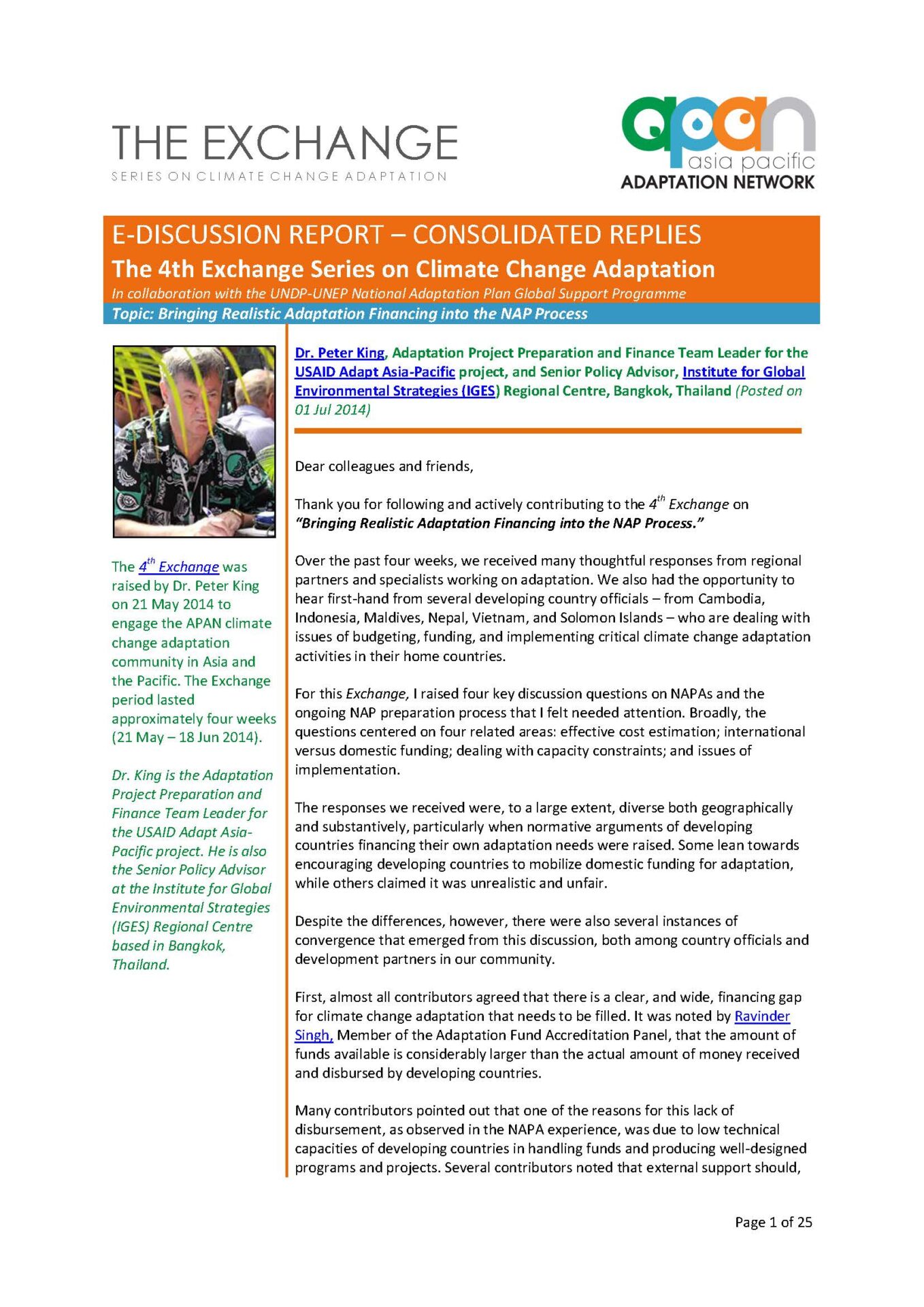The Exchange Series on Climate Financing

Summary
Access to information is the challenge at heart faced by developing countries in financing adaptation projects. Critical information and knowledge gaps in the region include: a) most climate change modeling and projections are only available at the global or regional levels, leaving the climate impacts at the local level still uncertain; b) as the new architecture for global adaptation funding is still emerging, the requirements needed for future adaptation projects remain largely unclear; and c) as the incremental climate benefits are often difficult to separate from the effects in traditional development projects, eligibility for adaptation funding has not be well-defined.
The Asia Pacific Adaptation Network (APAN) Exchange Series on Climate Financing is a facilitated email information exchange platform operated and supported by USAID Adapt Asia-Pacific. The Exchange seeks to capture, consolidate and share tacit, experience-based knowledge from the ADAPT Asia-Pacific country representatives and development partners.
Each of the Exchange Series asked participants to consider the specific questions. They allowed participants to share key lessons and challenges, and to highlight and provide insights from current activities in the Asia-Pacific region. Details of each of the Exchanges and detailed participant responses and other contributions are available below.
The Exchange Series Topics
- Majuro Declaration for Climate Leadership – A Climate Financing Perspective Climate change is a survival issue for many of the low-lying atoll Pacific Island countries and potentially damaging for the bulk of the population living in the coastal zones. The discussion focuses on the issues surrounding climate finance access for these vulnerable Pacific Islands.
- COP19, GCF and Business Involvement In this 2nd Exchange that ran through the entire COP19 season, we heard a diverse range of views from developing country representatives, researchers, and development partners on their expectations for the GCF.
- Is ‘resilience’ an operational alternative to ‘adaptation’? There appears to be little consensus in the conceptual understanding between ‘resilience’ and ‘adaptation’. If climate finance is to be “new and additional” then there is a justifiable concern that funding “resilience” may be used by donor countries to blur the distinction between Official Development Assistance and climate finance.
- Bringing Realistic Adaptation Financing into the NAP Process The discussion questions focus on NAPAs and the ongoing NAP preparation process in four related areas: effective cost estimation; international versus domestic funding; dealing with capacity constraints; and issues of implementation.
- Strengthening Country Systems to Access and Manage Climate Finance In preparation for the 2014 USAID Adapt Asia-Pacific Annual Forum, the discussion centers on the theme of the forum: Strenghening Country Systems to Access and Manage Climate Finance in Asia and the Pacific.
- GCF Capitalization and the Prospects for a Successful 2015 Climate Deal The discussion followed COP20 in Lima, Peru to seek opinion about the negotiations as they relate to climate finance (particularly, the capitalization/pledging of funds to the GCF) and how that might impact the post-2015 climate agenda.
- Mainstreaming Gender into Adaptation: Examples and Experiences In this discussion, many practical examples, as well as theoretical insights, on how to mainstream gender into climate change adaptation activities were shared from across Asia and the Pacific.
- Financing Urban Adaptation and Resilience From the discussion, two clear issues emerged: the question of how to ensure more efficient flow of money from the global level reaching the local level; and the challenge of matching national level and local level priorities.
- What Are Your Adaptation Priorities? Examples and Experiences Participants agreed that identifying priorities is the easy part, but taking pilot projects to scale after the priorities have been identified proves to be tougher and will require cross-institutional cooperation and coordination that can be challenging for many developing countries.
- Effective Capacity Building for Accessing Climate Finance: Examples and Experiences This discussion explored how best to develop country capacities to manage the project preparation process in order to ensure ownership and sustainability of adaptation activities.
- How Gender Integration Leads to Better Climate Change Adaptation Women are often excluded from decision making in relation to climate change adaptation. Participants shared their individual experience with women’s role in adaptation and activities supporting women’s empowerment on-the-ground.
- Ensuring Sustained Impacts of Donor-Driven Programs: Examples and Experiences Development programs come and go. How to ensure that donor-driven programs continue to deliver results beyond the life of the project? Suggestions include engaging communities, stakeholders and project beneficiaries to extend the impact beyond the life of the program.
- Building Capacities to Prepare Good Projects and Access Climate Finance Lack of capacity to design bankable projects usually comes up as a setback. Participants shared their local experience in preparing, implementing, and maintaining adaptation projects.
Funded through USAID’s Regional Development Mission for Asia (USAID/RDMA) and implemented by AECOM, USAID Adapt Asia-Pacific was designed to share information and best practices about climate change adaptation finance modalities and project preparation tools and help governments build capacity to access the existing pool of international climate change adaptation funds.
The Adaptation Finance Knowledge Series
USAID Adapt Asia-Pacific has been helping countries develop bankable adaptation projects and improve their access to funding. These experiences, published in this series, are based on our work with governments, multilateral and regional organizations, and other experts.
- Guidelines for Designing Bankable Adaptation Projects (2016)
- 6 Things to Know about Urban Adaptation (2016)
- Analyzing the Economic Costs and Benefits of CCA Options (2016)
- Shortlisting Climate Change Adaptation Projects (2015)
- Quick Guide to Climate Change Adaptation Funds (2015)
- Defining Country Systems for CCA Finance (2015)
- The Exchange Series on Climate Financing (2013-2015)
- USAID Adapt Asia-Pacific Annual Meeting Proceedings (2012-2015)
(0) Comments
There is no content